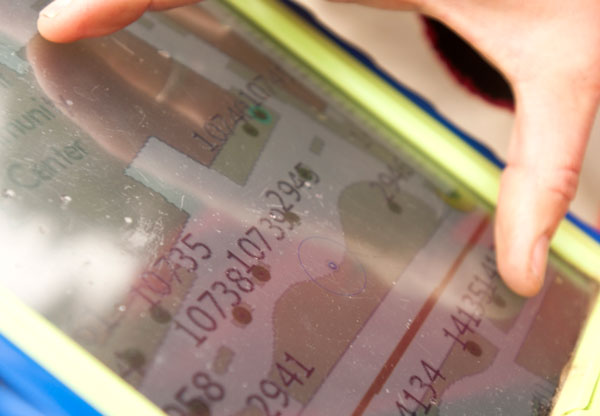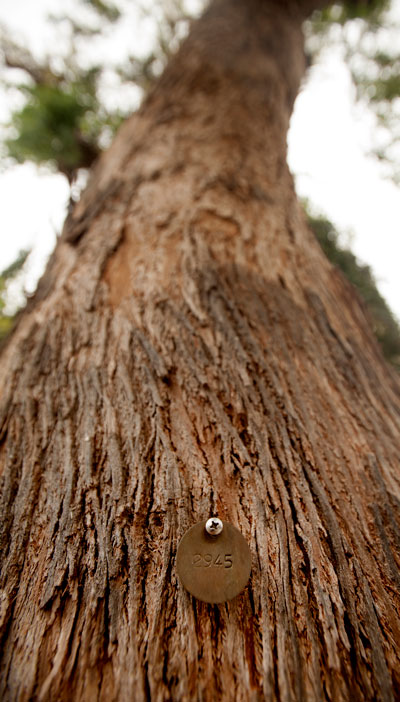Update on the Injured Parties
Campus officials gave this report today (April 7) on the injured parties: One was evaluated at the scene and three were taken by ambulances to area hospitals. The three people who were transported were released the same day.
They work hard, year-round, in all kinds of weather, inspecting and maintaining the campus’s trees, all 14,000 of them.
“So, when something like this happens, it’s devastating to us,” campus arborist Melanie Gentles said Thursday morning April 6), hand to her heart, speaking for the entire tree crew one day after a large limb fell from a tree in front of the Student Community Center, leaving four people injured.
Gentles last inspected the tree — a eucalyptus commonly known as a silver dollar gum — in August. She declared the tree safe and healthy.
It’s still healthy, she said. There’s no need to ask her if she thinks it is safe: Seated at a table under the tree, she said: “I’m not nervous at all.”
Campus officials said they do not know what caused the failure, noting they saw no signs of decay in the fallen limb or from where it had been growing out of the trunk.
“What happened was an unpredictable event,” Gentles said. And these events are rare: She recalled only one other instance of injury due to a falling tree limb in her 11 years here, in 2008, in the Regan Residence Halls area.
“When we choose to live among trees, we have to accept a certain level of risk,” Gentles said. But she and her colleagues — Melissa Boelman, John McKnight, Justin Morejohn and Justin Ross, arborists who do the actual tree maintenance — are constantly striving to keep that risk to a minimum.
All our trees on an iPad
They do so, in part, with a geographic information system that Gentles pushed for and helped develop when she came on board in 2006. She was a graduate student in entomology at the time (she eventually earned her master’s degree), but, armed with a Bachelor of Science degree in forestry from the University of Toronto, she took a part-time job as consulting arborist. She’s been at it ever since, still working half time (with three children at home).

The information system has no fancy name, no acronym! It’s just the Tree Management Program. Gentles keeps it close at hand, in an iPad. Both tree crews also carry iPads.
She pulls up the map that shows some 10,000 trees on the central campus. (Add in the arboretum, which keeps its own database, and trees south and west of campus, and the total tree count comes out to about 14,000.)
She zeroes in to Tree 2945 — the one that lost the limb Wednesday — and reads from her report dated Aug. 17, 2016: She downgraded the tree slightly for “weak foliage” (not perfectly green) and for branch scars. The scars are signs of pruning, “which is not necessarily a bad thing.”
“Other than that, I saw nothing else of concern,” she said. “No pathogens, no pests, no leaning, no decay.”
The database has about 40 data points for every tree, following standards established by the International Society of Arboriculture. Gentles and all her colleagues have ISA certifications.

Tree 2945’s future uncertain
Gentles made no recommendations for maintenance on Tree 2945 (if she had, the recommendations would have been posted to the GIS, alerting the two tree crews). “I walked away from this tree knowing that we had done our due diligence, that it was safe and healthy,” she said.
Nevertheless, in the wake of what happened Wednesday, “We’re going to think long and hard about whether this tree should stay,” Gentles said.
In the meantime, the campus tree crew did some trimming early Thursday, reducing the weight in advance of the storm coming in that day.
Gentles estimated the tree’s age at 50 years. So, of course, it was there when the Student Community Center was built in 2010-11. Campus planners kept the tree as a centerpiece for the plaza in front of the building.
But, when planting other trees in the plaza, the campus chose forest green oaks — and today, six years later, they are generally 20 feet tall.
“So, if we take out the eucalyptus, we can replace it with a tree that will grow rather quickly,” Gentles said.
Routine inspections
Gentles said the tree team has a goal of inspecting every tree at least once every five years, more often in the core campus. She noted that she inspected all of the core campus trees last year — roughly 4,000 in number.
With the GIS database — which replaced “a stack of binders,” she said — the tree crew has gone from being reactive to tree problems, to being proactive. This helps explain why, through all of this winter’s storms, the campus lost only 31 trees — or 0.2 percent of the total.
“I am proud to be part of a team of very skilled and hard-working individuals,” she said.
Their boss is proud, too. “They are a big part of the reason the Arbor Day Foundation has named UC Davis a Tree Campus USA for eight years running,” said Cary Avery, who leads Grounds and Landscape Services, part of Campus Planning and Environmental Stewardship.
Media Resources
Dave Jones, 530-752-6556, dljones@ucdavis.edu
